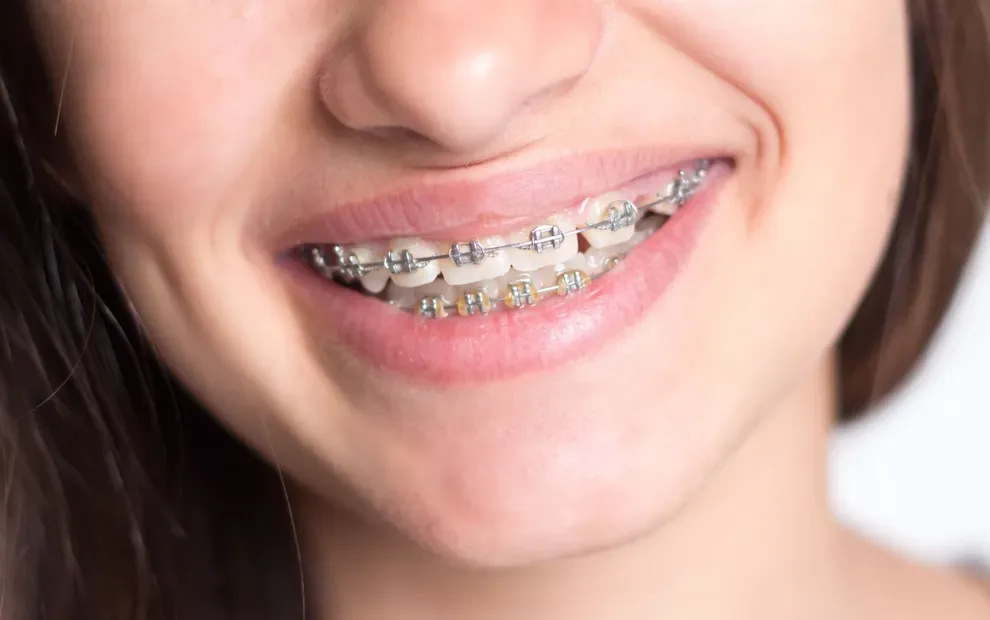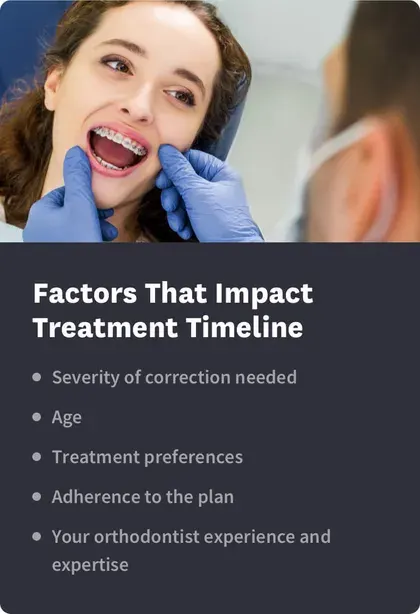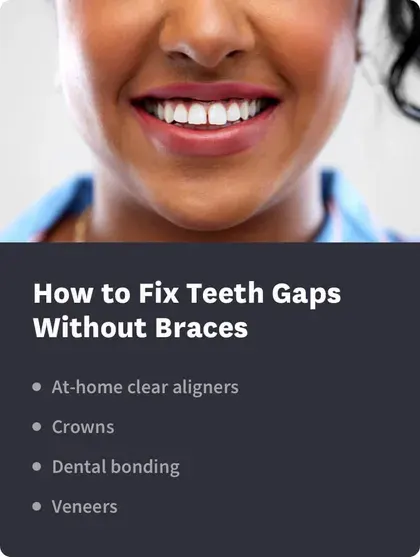How Long Do You Have to Wear Braces? Timelines

Table of Contents
- Impacting Treatment Time
- Are Aligners Faster
- Expected Treatment Time
- Timeline for Wearing Braces
- Why Treatment Time Matters
- Braces Treatment Times Explained
- Shortening Treatment Timeline
- Do Longer Treatments Cost More?
Ask several orthodontists about standard treatment times, and you'll get many different answers. Experts don't agree on one time frame that fits everyone.
But if you opt for treatment with braces, expect to wear them for several months. You might need to wear them for several years.
Five key factors dictate how long treatment will last. Some issues you can control, although others cannot be amended.
Is there an expected treatment time?
Nearly every person thinking about braces asks about treatment timelines. Unfortunately, there are no clear answers. Researchers point out that there is no official consensus on how long treatment with braces will take.
Some people need treatment for six months or less. Most people need about two years. But it’s not uncommon for people to stay in braces for three years or even longer.
How long do you have to wear braces? A general timeline
Several factors are involved in your braces treatment time frame. When your treatment starts, your team should explain how long the program will last and what steps are involved. However, this general timeline can help you understand what’s typically involved:
Age 7: Your first orthodontic visit happens. At this stage, your dental team assesses your health and provides care (like palate expanders) that could make braces treatment easier.
Ages 9-14: Your braces are applied.
Every 4-8 weeks: Your braces are adjusted by tightening the wires.
Up to 3 years: The braces stay on your teeth.
At least a year: You wear a retainer to keep your teeth in place.
5 Key Factors That Impact Treatment Time
When you meet with an orthodontist to talk about braces, treatment time will come up. You'll be told how long your therapy will last, and that estimate will be based on a variety of factors.
Your treatment may be long or short due to:

Severity: Do you have several teeth out of position? Or do you have just one or two that need a minor push? The more work your orthodontist must do to get your smile in shape, the longer you'll be in braces. (See the chart on this page for more information about how severity impacts the length of your orthodontic treatment.)
Age: Children typically have braces for two years. The American Association of Orthodontists explains that adults often need to wear braces longer than children, as their bones are more mature and dense.
Extractions: Some people have extra teeth or too-small jaws. Dentists extract the extra teeth, and doctors use braces to close the gaps left behind. Researchers say that removing teeth tends to increase treatment times. The more teeth removed, the longer it might take.
Adherence to the plan: Braces need frequent adjustments. You must visit your orthodontist, sit in the chair, open your mouth, and allow the team to tighten your wires. Skip appointments, and you'll spend more time in braces.Researchers say that every missed appointment can add a month to your treatment time. This makes sense, as missing appointments means your wires aren’t tightened on the right schedule.
Your time in braces is dependent on many factors, including some you can't control so expect to measure your time in months (not weeks).
Braces treatment times explained
How long do you have to wear braces? The answer often depends on the severity of your dental issues. This table can help you understand how your dental problems can impact how long you wear braces.
Factor | Treatment Length |
Mild dental problems* | About 28 months |
Moderate dental problems* | About 30 months |
Serious dental problems* | More than 30 months |
Missed appointments* | Added month to treatment per missed appointment |
Why does treatment time matter?
Your teeth are a critical part of your body. You use them to eat, drink, and swallow. Treatment can help keep them healthy, and it's reasonable to seek out care when your smile isn't ideal.
But it's not unreasonable to consider how long treatment will take. For many people, a long treatment timeline is a barrier to care. They can't afford to spend years in treatment, and they'd like to look for opportunities to make things quicker.
In studies of customer satisfaction, researchers say people are happiest when their treatment timelines are short, and they must wear few appliances while they're working on their smiles.
How can you help shorten the treatment timeline?
Paying close attention to instructions and keeping all of your appointments is one of the best ways to ensure that you don't spend more time in braces than needed.
You can also shorten your timelines by:
Caring for your mouth. Bacteria cause your gums to swell, and when they do, they can block your teeth from moving. Brush regularly, and use fluoride rinses to keep infections away.
Protecting your appliances. A blow to the mouth can damage your braces. You'll lose critical treatment time while you wait for a repair. Use a mouth guard during sports, and avoid snacking on sharp or sticky foods.
Reporting problems quickly. Orthodontists use estimates in their work. Your mouth may move faster or slower than your team expects. If you notice something unusual, tell your doctor right away.
Do longer treatment time frames cost more?
Unfortunately, more complex treatment plans do cost more. Your orthodontist must offer more tightening appointments for complicated cases, and each one requires staff, equipment, sanitation, and more. Those costs can get passed to you.
Research from CostHelper suggests that most orthodontists use a per-case pricing system. Don’t expect a bill for each appointment with your doctor — or the opportunity to cut the cost by ensuring that your project moves faster.
However, know that longer treatment time frames take longer.

Are Aligners Faster?
If you don't want to spend years in braces (and few people do), consider aligners. Depending on your specific needs and the type of aligner used, this type of treatment can take anywhere from 3 to 9 months.
Aligners are clear, plastic trays that slip over your teeth and cover them from root to tip. They apply gentle pressure to encourage your teeth to take up new positions. Each week or so, you'll upgrade to a new tray that changes your teeth even more.
Aligners aren't right for every dental health problem. For example, if you have several teeth that must be moved long distances, you might need more help than aligners can provide.
But if you are right for aligners, you could see shorter treatment timelines than you would with braces. And since teeth aligners are smooth, rather than rough like braces, they're more comfortable to wear too.
